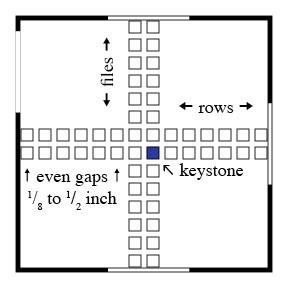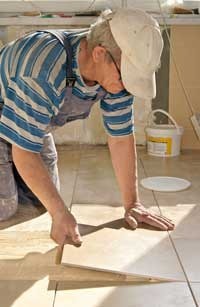Installing ceramic tile might seem a daunting task but it really is well within the grasp of most people. The only steps involved are layout, setting, and grouting.
In case you haven't noticed, the walls in most houses are not built perfectly square to one another, so layout tries to find the best line for your floor tiles to follow. You will be looking to minimize the amount of visible evidence of floor tiles being out of square to any of the walls in a room. This may or may not involve skewing the plane of rows and files of tile. Lay out a row and file or two, keeping the gap between tile at a quarter inch.

Use the adhesive manufacturer instructions for mix ratio and trowel notch size. For ceramic, the adhesive is named thin set and believe me, with this stuff, you must follow the mixing instructions exactly. Mix only a small amount at a time.

Spread a layer of thin set on a small section of the floor, up close to but not on that pencil line you drew. Now take a tile and while holding it top side down on the fingertips of one hand, and with the underside orientation markings always running the same direction, trowel on an even layer of thin set. Carefully turn the tile over, and while avoiding messing your fingers with adhesive, plop the tile onto the thin set bed you previously spread. Squiggle the tile, using downward force and sideward coaxing, into place precisely on the pencil line. Your first ever tile now serves as the cornerstone, a landmark, irreversible keystone tile for the rest of this project. Continue setting tile with the same gap or spacing and orientation. The final row and file may need cutting to size with a rented sliding point cutting tool. Leave a day for the thin set to dry.
Grouting is simply filling the gap line between all the tile you set yesterday. It's ok to walk carefully on your new floor. Mix your grout according to manufacturer instructions. If your gap is greater than an eighth, use sanded grout. Beginning in a corner, plop a pile of grout right down there on the tile and using a rubber float tool, immediately begin working the mixture into the gap. Push the mixture in hard, taking care not to have voids or pin holes. Keep a bucket of clear water and grouting sponge at hand so you can sponge clean the excess of grout left behind after floating. Keep the sponge damp, not wet, and rinse often.
Taking care not to disturb the grout lines, use damp then dry rags to clean the surface haze that forms and you should be ready for the final stage which is to admire your work!
By Dennis Fitter
Add your voice! Click below to comment. ThriftyFun is powered by your wisdom!